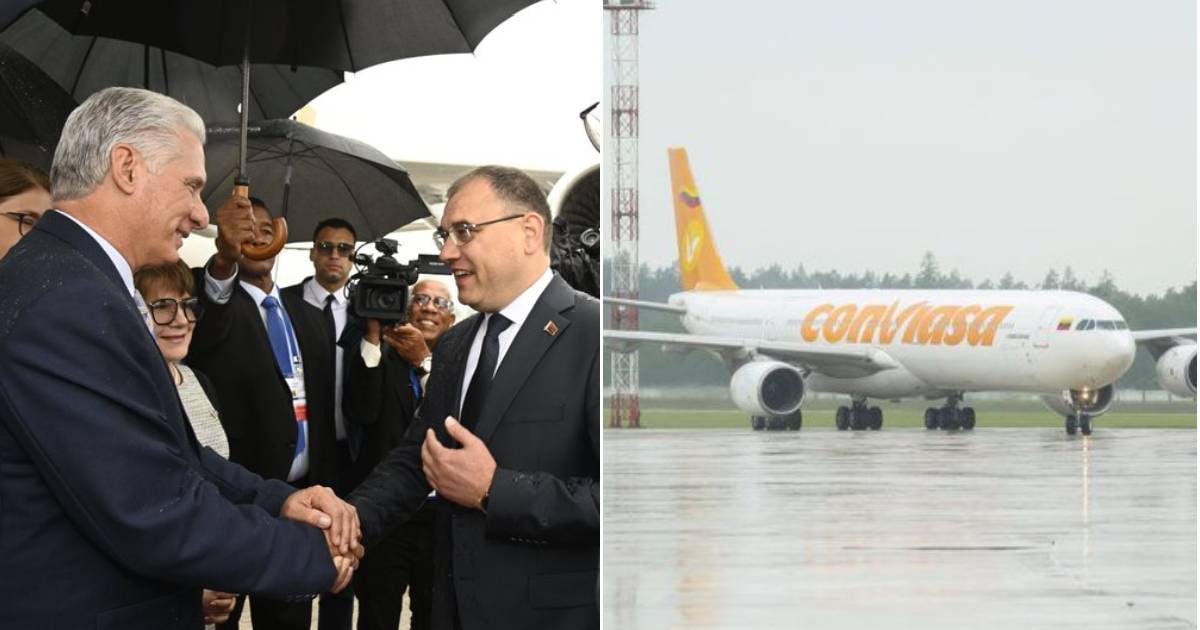Cuban leader Miguel Díaz-Canel and his wife Lis Cuesta touched down in Belarus this Tuesday aboard a plane from the Venezuelan state airline, Conviasa. This journey occurs amidst one of Cuba's most challenging energy crises in recent years, characterized by power outages lasting up to 24 hours and a growing wave of social unrest. "Dear people: We are heading to Belarus for an official visit and to participate in the Supreme Eurasian Economic Council meeting," Díaz-Canel posted on the social media platform X (formerly Twitter), ahead of his departure on the Venezuelan aircraft. This plane is typically used when Cubana de Aviación's sole IL-96-300 is unavailable for long-distance travel by the Cuban leadership.
According to Belarusian state channel Belarus 24, the Cuban president has arrived in Minsk, where his first agenda item is a meeting with President Alexander Lukashenko, one of his key international allies. This marks Díaz-Canel's second official visit to Belarus following his trip in 2019. Since 1992, both governments have maintained diplomatic ties regarded as "excellent" by Havana, with agreements spanning biotechnology, agriculture, healthcare, machinery, and sanatorium tourism.
The Cuban ambassador in Minsk, Santiago Pérez Benítez, noted that over 40 university agreements have been signed, and more than 50 Belarusian medications have been certified in Cuba. Additionally, there are plans to upgrade agricultural equipment and establish assembly centers on the island.
However, while the Cuban leader engages in summits and bilateral meetings, the Cuban populace is grappling with a severe energy crisis. On Monday, the Cuban Electric Union (UNE) reported disruptions in service throughout the day, with a peak deficit of 1,770 MW at night, nearly half of the national demand. This crisis is exacerbated by the collapse of several thermoelectric plants, fuel shortages, and outdated technology. The recently installed 16 solar parks in the country contribute a mere 402 MW at their peak, an insufficient amount to alleviate the ongoing crisis.
Moreover, recent weeks have seen university students protesting against the sudden hike in mobile internet tariffs, set in dollars by the state-run ETECSA, and the discontinuation of top-ups in Cuban pesos, which has deepened digital access inequality.
Meanwhile, the Cuban government continues to strengthen its alliances with authoritarian regimes like Russia and Belarus, sparking skepticism among the populace about whether these international visits will result in tangible benefits for everyday Cubans. The use of Conviasa planes for these trips, analysts suggest, highlights both the close relationship between the governments of Havana and Caracas and the limitations of Cuba's own airline fleet, which is restricted in international operations due to sanctions and resource shortages.
Díaz-Canel's trip coincides with a wave of criticism on social media, where users express dismay that the president and his entourage are traveling abroad while most residents on the island endure life without electricity, sweltering heat, food shortages, and deteriorating basic services.
Key Questions About Cuba's Current Situation
What is causing the severe energy crisis in Cuba?
Cuba's energy crisis is primarily due to the collapse of thermoelectric plants, fuel shortages, and outdated technology, resulting in significant power outages.
How are Cuban citizens reacting to the current situation?
Cubans are expressing growing discontent, with protests occurring over increased internet tariffs and the enduring energy crisis, highlighting widespread frustration.
What is the purpose of Díaz-Canel's visit to Belarus?
The visit aims to participate in the Supreme Eurasian Economic Council meeting and strengthen diplomatic ties with Belarus, an important ally of Cuba.
